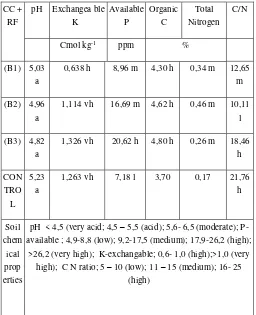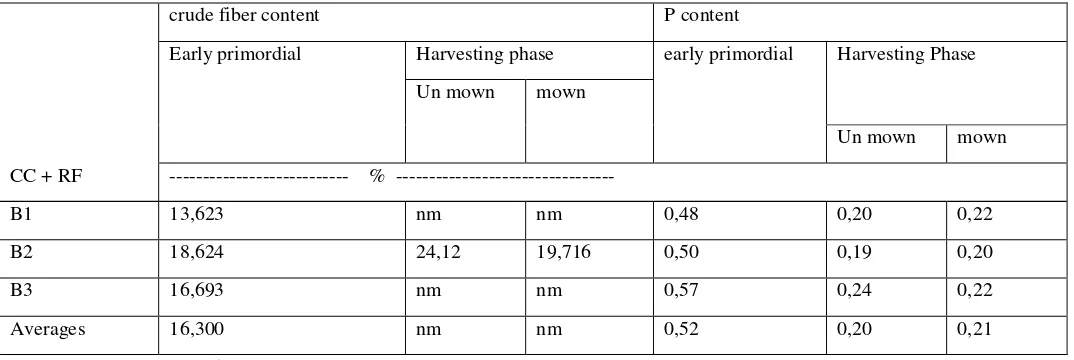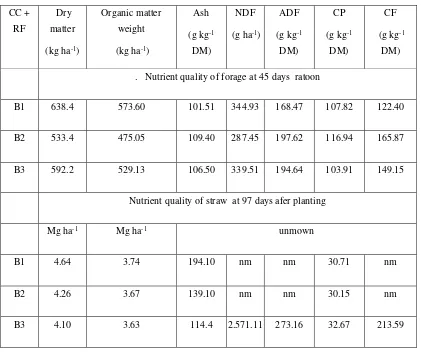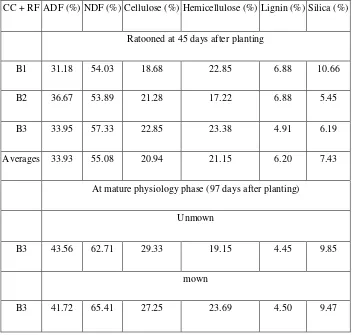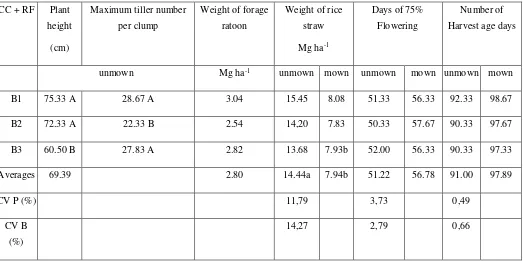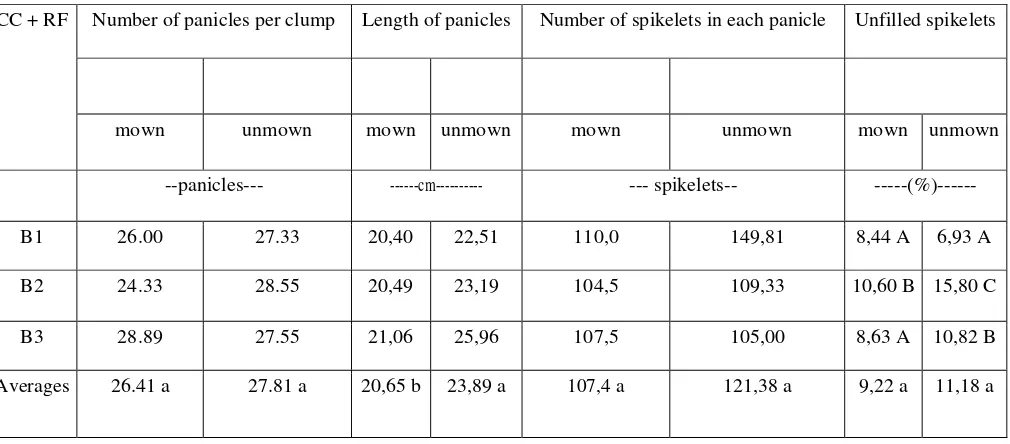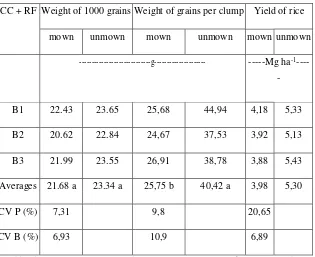Mowing Rice Crop as Ratoon and Applying
Chromolaena odorata
Compost
to Support Food Security
Jamilah Munir1*, Juniarti2, And Srimulyani3
1Agrotechnology Department, 2Soil Science Department, 3Animal Husbandry Department Agriculture
1,2,3 Agriculture Faculty in Universitas Tamansiswa, Indonesia;Jl. Tamansiswa No. 9 Padang, Post Code 25138; Indonesia.
1Orcid: 0000-0002-2153-9596
Abstract
Ratooning rice 45 days after planting is an effective means of forage production that allows a good rice harvest in addition. The objectives of this study were to determine the effect of mowing rice crops and applying composted Chromolaena
odorata or C.odorata + NPK fertilizers application on days to harvest and yield of ‘Red Cempo’ brown rice. The experiment was conducted in Sungai Lareh, at Padang City, West Sumatra, Indonesia, from May 2015 to August 2015, on Ultisol soils. The experiment was arranged in a split-plot design, where the main plots were either unmown (P0) or mown at 15 cm above ground at the flag leaf fully emerged stage of growth (P1). Subplots were fertilized with varying levels of combinations of composted C. odorata + NPK fertilizer applications. These combinations consisted of: B1) 5 Mg ha-1 C.odorata compost (CC) + 100% fertilizer
recommendation (FR); B2) 7.5 Mg ha-1 CC + 75% FR; and
B3) 10 Mg ha-1 CC + 50% FR. Treatments were replicated
three times. All data were tested by using Analysis of variance (ANOVA) p< 5%, and the real test LSD p< 5%. The parameters tested were soil analysis, analysis of the forage nutrient content, the harvest age. Results of the experiments showed that Harvesting forage is feasible if it doesn’t lengthen the harvest age nor lower the yield of Red Cempo. The yields of ratoon forage from ‘Red Cempo’ rice averaged 2.80 Mg ha-1. Amending soils with various combinations of
doses of C.odorata compost and artificial fertilizer significantly affected to plant height, the number of tillers, and unfilled spikelet percentages. The good treatment was 5 Mg ha-1 CC + 100% FR, and reached dry grain harvested an
average of 4,18 Mg ha-1 from rice in the plots mown for
forage crops at the beginning of the primordial phase.
Keywords: C.odorata Compost, forage, Red Cempo Brown Rice.
INTRODUCTION
Rice is a staple food crop in Indonesia and is constantly being developed and intensively cultivated both in paddy fields as well as on dry land fields. Indonesian national dependence on rice is very high, but the carrying capacity to meet the food needs is still low in the tropical soils of the country. In 2012, Indonesia’s rice imports amounted to 1.8 million tons with a value of US $ 945.6 million ( BPS, 2013). Indonesia’s rice cultivation is done on rain-fed tropical soils. Recently, brown rice cultivation has increased. Brown rice is very popular with the public, and the market price is more than double the price of white rice. Some of the reasons people like brown rice are that it contains a low sugar content, but it has high levels of B vitamins and fiber. The high fiber content in brown rice is preferred by people interested in losing weight, those with heart problems, and diabetics.
Farmers who are also ranchers and keep cattle often face difficulty procuring forages because there is limited land available for cropping grass. Elephant grass is the typical forage grass grown for cattle and is grown on dry land. If the Sawah is planted to cropped forage grass, it would be detrimental to farmers because they wouldn’t be able to use the land for raising the more valuable rice crop, so farmers are reluctant to raise grass. Therefore, procuring forage becomes increasingly difficult. Rice straw can also be used as animal feed but must be supplemented if used as forage. Rice straw is low in protein and high in crude fiber, so the quality is low, therefore only 20 -30% of the nation’s straw production is used for forage, and the rest is composted or burned (Jamilah, Fadhila, and Mulyani, 2017); (Hynes, Stergiadis, Gordon, and Yan, 2016); (Harrell, Bond, and Blanche, 2009).
family, has growth characteristics similar to forage grasses. The nature of grass allows it to be able to be mown repeatedly in a given period. Mowing rice crops at a young age (early to fully emerged flag leaf stage) allows rice crops to provide both grain and a new source of forage rather than using grasses grown solely for forage. Some constraints of this system are that mowing the forage as ratoon from the rice crop can reduce rice yields and delay the harvest age. It is still not known how much brown rice grain yield is reduced due to a cutting of green rice crops. To solve the above problems, it will be necessary to provide soil nutrients to protect the quality of the crops. Organic fertilizer from composted
Chromolaena odorata (C.odorata) was shown to increase maize yields on marginal lands in West Sumatra Sijunjung (Jamilah et al., 2009); (Jamilah, 2011); (Jamilah, 2010). This project was undertaken to provide information on the effects on the rice crops when ratooned, a practice that is not commonly done by farmers. The research objective was to determine the effect of mowing forage as ratoon in conjunction with applying various rates of composted
C.odorata + artificial fertilizers application on growth and yield of rice grain grown on this tropical soil.
MATERIALS AND METHODS (P0) and those mown at 15cm above ground at the beginning of flower primordia (P1). The subplots consisted of three treatments using various combinations of composted
C.odorata (CC) and Fertilizer Recommendation (FR): B1) 5 Mg ha-1 CC + 100% FR; B2) 7.5 Mg ha-1 CC + 75% FR; and
B3) 10 Mg ha-1 CC + 50% FR. The treatments were replicated
three times, so there were 2 x 3 x 3 = 18 experimental plots. The artificial fertilizer recommendation included 100 kg ha-1
urea, 50 kg ha-1 ammonium sulfate, 150 kg ha-1
superphosphate 36, and 100 kg ha-1 KCl.
The parameters measured in the experiment included soil analysis before and after treatment, including pH, organic C, total-N, exchangeable K, and available P. Forage nutrient content was measured using Van Soest Analysis on material collected during the mowing as ratoon and the straw harvested at the end of the growth phase. Parameters measured included protein content, ash, forage dry matter weight, organic matter, crude fiber content, crude protein, and C-N ratio. Agronomic factors studied included plant height,
the maximum number of tillers, age at 75% rice flower The soil analysis data and data on the analysis of the nutrient content of animal feed are displayed in tabular form only. The results of chemical analysis of soil were not analyzed statistically, only tabulated.
The forage analysis was carried out by the micro-Kjeldahl method for N, elemental P, and organic-C- spectrophotometry. Analysis for K, Ca, Na and several microelements (Fe, Zn, Co, Cu, B and Mn) were determined using Atomic Absorption Spectrophotometer (Perkin-Elmer 3110; J and W Scientific, Folsom, CA, USA). Determination of pH (soil and water) 1:10 (v/v) using a pH electrode. According to (Hynes et al., 2016); (Goering & Soest, 1970) the acid-detergent fiber (ADF) procedure provides a rapid method for lignocellulose determination in feedstuffs. The residue also includes silica.
material that would interfere with the lignin determination. The ADF residue consists of cellulose, lignin, cutin, and acid-insoluble ash (mainly silica). Treatment with 72 percent sulfuric acid dissolves cellulose. Ashing of the residue will determine the crude lignin fraction including cutin. For silica determination and separation of cutin and lignin, see the Permanganate and Acid Detergent Cutin Procedures. Add to the crucible containing the acid-detergent fiber an amount of asbestos about equal to the volume of fiber. Cover the contents of the crucible with cooled (15° C). 72 percent H2SO4 and stir with a glass rod to a smooth paste, breaking all lumps. Fill crucible about half full with acid and stir. Let glass rod remain in a crucible; refill with 72 percent H2SO4 and stir at hourly intervals as acid drains away. Crucibles do not need to be kept full at all times. Three additions suffice. Keep crucible at 20° to 23° C. After 3 hours, filter off as much acid as possible with the vacuum; then wash contents with hot water until free from acid. Rinse and remove stirring rod.
3. Dry crucible at 100° C. and weighed. 4. Ignite crucible in a muffle furnace at 500° to 550° C. for 3 hours, and then cool to 100° C and weight. (LxlOO)/S = ADL; where: L = loss upon exchangeable K, low available P, high organic C, low total N, and a high C-N ratio. The higher the rate of C.odorata compost, the more acidic the soil became. In uncultivated land, it can be seen that the pH is generally higher than that cropped to rice. In general, the exchangeable K in these soils ranges from high to very high. The treatments also showed that the higher the dose of C.odorata compost given, the higher the exchangeable K became in the soil.
The effect of the KCl that was applied along with C.odorata compost is unclear. It’s possible that virtually all of the artificial K fertilizers were absorbed by the crop. Other possibilities include strong fixation by clay minerals or leaching with irrigation water, as explained by Soetedjo and Kartasapoetra (1988). Buckman and Brady (1984) state that leaching in wet areas such as paddies can cause high K losses, creating the need for potassium fertilizers if K demand in the desired crops is moderate or high. Available P levels and organic C increased with higher rates of compost (Table 1).
Table 1: Soil chemical exchanged applied fertilizer as treatment available ; 4,9-8,8 (low); 9,2-17,5 (medium); 17,9-26,2 (high);
>26,2 (very high); K-exchangable; 0,6- 1,0 (high);>1,0 (very high); C N ratio; 5 – 10 (low); 11 – 15 (medium); 16- 25 plots. Artificial fertilizer was not as effective at increasing available P as the compost. We think the available P increased because the CEC of the soil would have increased as the organic fertilizer rate increased. This would allow some of the soluble Fe ions that adsorb P to be taken out of the soil solution. The organic matter could also create carboxylic and phenolic groups to form organometallic complex sorption complexes or chelates, allowing the increase in soluble P. The physical characteristic of the rice fields in the study site suggest high levels of soluble Fe. These results suggest that it is very important to apply compost as an organic fertilizer to the soil of rice fields, where rice cultivation is done by SRI (the System Rice Intensively). According to Buckman and Brady (1984), soluble ionic forms of P in acid soils such as H2PO4- and HPO42- are both very easily absorbed by crops
and fixed by Fe.
The C-N ratio was higher on land that was not given fertilizer. Based on the interpretation of chemical properties of the soil, the concentration of total N in the amended plots increased to moderate levels, while the N level on the uncultivated land was low.
The B3 treatment resulted in the lowest total N-content among the amended plots, but it had the highest C-organic content and produced the highest C: N ratio among the amended treatments, although still lower than the control. This is because the nitrogen elements undergo immobilization in the soil so that the N elements are often found in the bound form, the form of amino acid compounds or proteins. This may occur, of course, due to the highest dose of compost treatment without the introduction of artificial fertilizers. As already explained by Gami et al. (2009); Ghmire et al. (2009);
Ghmire et al. (2016) and Kader et al. (2017); the application of organic manure to paddy fields in an anaerobic environment will slow the release of N, as result in a high C-N ratio.
The content of crude fiber and phosphate content in forage and rice straw are presented in Table 2. In general, crude fiber percent was lower and phosphorus percent was higher in the forage from the mown crop than in straw. The percent of crude fiber was higher in crops fertilized with lower rates of artificial fertilizer (B2 and B3), compared to crops that received higher rates of artificial fertilizer (B1). Increasing organic matter or the decrease in phosphate fertilizer higher happened in early primordial phase and decreased after entering the mature phase of physiological.
Table 2. Crude fiber and P percentages of the forage and rice straw
CC + RF
crude fiber content P content
Early primordial Harvesting phase early primordial Harvesting Phase
Un mown mown
Un mown mown
--- % ---
B1 13,623 nm nm 0,48 0,20 0,22
B2 18,624 24,12 19,716 0,50 0,19 0,20
B3 16,693 nm nm 0,57 0,24 0,22
Averages 16,300 nm nm 0,52 0,20 0,21
Notes: nm = not measured
Table 3. The C-N ratio and crude protein in forage and rice straw
CC + RF C-N ratio crude protein in forage content (%)
Primordi al early Physiological phase Primordia early
Physiological phase
Un mown Mown Un mown Mown
B1 24,43 41,96 57,15 12,00 2,81 5,44
B2 17,34 36,76 59,36 13,13 3,50 5,25
B3 17,64 45,30 52,92 11,63 3,69 5,00
Phoshporus percentages in the mature rice straw were less than 50% those of the forages harvested at the beginning of primordial flowering. Winugroho et al., (1983) also reported low available phosphorus content in rice straw. In addition to the low protein content, rice straw also has a low dry matter digestibility value and low organic matter content, between 34-52% and 42-59% respectively (Winugroho et al., 1983). This low digestibility also causes low dry matter intake, ie only 2% of body weight.
The C-N ratio was lower in the forage harvested at the initial phase of primordia than in the straw from mature rice. The C-N ratio value could reach up to a two fold increase or more when the crop has entered the mature phase of physiology. The lower value of C-N ratio in the forage harvested at the initial primordial phase low shows that this forage is more easily digested by ruminants than rice straw. The straw harvested from the mown plots also had higher protein content than that found in the straw from the unmown plots (Table 3).
Lower C/N values correspond to greater digestibility in cattle compared to materials with high C/N values. When
compared with forage from elephant grass, Zubaidah (2008) reported ash content in the elephant grass crops ranging from 8.24 to 12.48% and Zulbardi (2000) reported ash at 10.29%, so the ash content of the immature rice forage is similar to the level of elephant grass. In Indonesia, waste straw is not fully utilized. Research results from Duong Ngo (2009) showed that combustion of 1 Mg of a straw causes a loss of 91.3% of the carbon (C), equivalent to 291.2 kg C and also releases 1,068 kg of CO2, and 12.6 kg N.
As reported earlier by (Sutardi et al., 1982; Zulbardi et al., 1983; Sitorus, 1989; Jackson, 1977) rice straw is characterized by low protein content, minerals, and energy. As a consequence, it has a low nutritional value for feeding livestock. The protein content of rice straw varies between 3-5%. Therefore, we recommend that before being fed to livestock, it should be fermented for a few days to increase the availability of P and K. Mandal et al. (2004) reported rice straw yields at 7-10 Mg ha-1. However, rice straw consists
mainly of cellulose, hemicellulose, and lignin, with low levels of a protein that makes the C/N values high (Table 4 and 5). Gaur (1981) reported C-N ratios from fresh mature rice straw from 80-130.
Table 4: The effect of mowing and CC + FR to the nutrient quality of rice plant as forage
CC + RF
Dry matter (kg ha-1)
Organic matter weight (kg ha-1)
Ash (g kg-1
DM)
NDF (g ha-1)
ADF (g kg-1
DM)
CP (g kg-1
DM)
CF (g kg-1
DM) . Nutrient quality of forage at 45 days ratoon
B1 638.4 573.60 101.51 344.93 168.47 107.82 122.40
B2 533.4 475.05 109.40 287.45 197.62 116.94 165.87
B3 592.2 529.13 106.50 339.51 194.64 103.91 149.15
Nutrient quality of straw at 97 days afer planting
Mg ha-1 Mg ha-1 unmown
B1 4.64 3.74 194.10 nm nm 30.71 nm
B2 4.26 3.67 139.10 nm nm 30.15 nm
mown
B1 2.42 2.10 133.3 nm nm 47.14 nm
B2 2.35 2.04 130.7 nm nm 45.64 nm
B3 1.23 1.08 120.5 804.54 272.89 43.98 173.12
CV P 14,81
CV B 20,73
Notes: nm= not measured
Table 5: the Effect of mowing and CC + FR to the nutrient quality of rice plant as forage and straw
CC + RF ADF (%) NDF (%) Cellulose (%) Hemicellulose (%) Lignin (%) Silica (%)
Ratooned at 45 days after planting
B1 31.18 54.03 18.68 22.85 6.88 10.66
B2 36.67 53.89 21.28 17.22 6.88 5.45
B3 33.95 57.33 22.85 23.38 4.91 6.19
Averages 33.93 55.08 20.94 21.15 6.20 7.43
At mature physiology phase (97 days after planting)
Unmown
B3 43.56 62.71 29.33 19.15 4.45 9.85
mown
B3 41.72 65.41 27.25 23.69 4.50 9.47
There was an influence of C.odorata compost on rice crop height. Crop height decreased as artificial fertilizer rates were reduced and the rates of C.odorata compost were increased. Plots that received artificial fertilizers at 100% and 75% of
Table 6: The effect of mowing and CC + FR to Rice crop growth component
CC + RF Plant height
(cm)
Maximum tiller number per clump
Weight of forage ratoon
Weight of rice straw Mg ha-1
Days of 75% Flowering
Number of Harvest age days
unmown Mg ha-1 unmown mown unmown mown unmown mown
B1 75.33 A 28.67 A 3.04 15.45 8.08 51.33 56.33 92.33 98.67
B2 72.33 A 22.33 B 2.54 14,20 7.83 50.33 57.67 90.33 97.67
B3 60.50 B 27.83 A 2.82 13.68 7.93b 52.00 56.33 90.33 97.33
Averages 69.39 2.80 14.44a 7.94b 51.22 56.78 91.00 97.89
CV P (%) 11,79 3,73 0,49
CV B (%)
14,27 2,79 0,66
Figures followed by the same small letter on the same line or capital letters followed by the same column are not significantly according to LSD 0.05.
Mowing the rice crop as fodder significant effected day to flowering and harvesting of the brown rice crop (Figure 1). Harvesting age is determined by the age at flowering. It takes 40 days for the crop to grow from the 75% of the flowering stage until harvest. This data shows that the ‘Red Cempo’ brown rice crops that were mown at the early primordial growth stage took an additional 5- 8 days to reach flowering and harvest compared to crops that were not mown.
Mowing at the beginning of floral primordia yielded an average of 2.8 Mg ha-1 of forage as fresh stover. Forage
quality of the rice crop was very good for ruminants due to its higher nutrient content and lower fiber content compared to the straw that was harvested with the mature crops. Rice straw can also be used as animal feed, but it has lower quality than the mown forage. Rice straw is typically used as fermented animal feed to improve its quality as ruminant feed. Antonius (2009) reports dry matter content of physiologically mature straw of 44.88%; with 4.5% crude protein 30.31% crude fiber.
Yields of rice straw can reach 12-15 Mg ha-1 crop-1,
depending on the location and type of crop varieties of rice used. This is a large amount of material that could be used for various purposes such as animal feed, organic fertilizer, or as mulch for melon crops. However, most rice straw is lost because too many farmers burn the straw after harvest on the field. Rice straw takes a long time to decompose. Speeding up
the decomposition process of straw often requires the addition of decomposers, such as bacteria or fungi that are able to produce the enzyme cellulase (Meryandini et al. 2009). When compared to the crude protein content (CP) between the Rice crops were produce new shoots and the formation of generative parts (Table 6).
The mown plots bloomed 6 days later than the unmown plots. Mowing inhibits vegetative growth because it removes energy that had been stored in the stems and demands more energy to be taken from the roots in order to restore growth. Comparing the forage from rice mown at 47 days after planting with a superior elephant grass crops, the rice forage is superior quality with P and K content 30% higher.
Comparing the crude protein content (CP) of the rice crops mown at 47 days after planting with a superior elephant grass crop, the rice crops are superior quality with phosphorus and potassium content of 30% higher. According to Jamilah et al (2011), Basmati rice varieties could reach 17.69%, crude protein higher than the crude protein of rice crop at paddy soil.
plants. Applying compost can increase the cation exchange capacity of the soils and reduce the effect of metals that endanger the growth of plants such as Fe, which is quite high in Ultisol soils. Furthermore, Ghimire, R., Lamichhane, S., Acharya, BS; Bista, and P. Sainju (2016) stated that the compost that enriches soil organic matter is more dynamic in influencing the soil pH, decreasing levels of C, N, and S.
It turns out that the yield of paddy straw is strongly influenced by the effects of mowing. In general, mowing for ratoon can reduce the yield of mature straw by nearly 50%. Similarly, the age at flowering and harvesting is greater in mown plants than unmown by up to 7 days, although these are not significantly different. Dong et al. (2017) also explain that mowing a rice crop will produce a shortened node or segment that will affect the weight of the straw it produces.
The average number panicles per clump and the number of spikelets per panicle did not differ between the mown and unmown crops, but mowing did affect panicle length (Table 7). In general, the mown crops tassels are shorter compared to the unmown crops. The combination of fertilizer treatments from various sources did not affect productive tillers, panicle length or the number of spikelets per panicle.
Mowing greatly affected average panicle length in ‘Red
Cempo’ brown rice. Crops that were mown produced panicles that were shorter. This was due to decreased energy produced by crops through photosynthesis in the crops that were harvested for green cattle feed. There is less energy left in the mown crops after harvesting for ratoon, so crops need more time to form a panicle and the resulting panicles are shorter. Even though immature rice crops recover from harvesting as ratoon, more research is needed to determine if there is a better mowing height so crop yield does not decline. High or low levels of mows will determine the extent of food reserves lost by harvesting as forage. As reported by Jamilah (2015), mowing at a height of only 5 cm from the surface of the soil delayed flowering and harvest up to 10 days. High and low levels of mowing also affected the age of the rice crops at harvest. In this study, mowing along with applying 5 Mg ha-1
of composted C.odorata + artificial fertilizer at 100% of the recommended rate resulted in the least amount of unfilled spikelets (Table 7), but the unmown treatments averaged higher numbers of unfilled spikelets.
Artificial fertilizers contain high amounts of nutrients in a given weight of material and the availability of those nutrients to the crop is also high. Furthermore, crops more easily absorb nutrients from artificial fertilizers than from most organic fertilizers. It was also shown by Barus (2011) that applying organic fertilizer derived from rice straw compost at rates up to 10 Mg ha-1 resulted in unfilled spikelets of 10 -
13,7%.
Table 7: The Effect of mowing and CC + FR to the panicles component
CC + RF Number of panicles per clump Length of panicles Number of spikelets in each panicle Unfilled spikelets
mown unmown mown unmown mown unmown mown unmown
--panicles--- ---cm--- --- spikelets-- ---(%)---
B1 26.00 27.33 20,40 22,51 110,0 149,81 8,44 A 6,93 A
B2 24.33 28.55 20,49 23,19 104,5 109,33 10,60 B 15,80 C
B3 28.89 27.55 21,06 25,96 107,5 105,00 8,63 A 10,82 B
Averages 26.41 a 27.81 a 20,65 b 23,89 a 107,4 a 121,38 a 9,22 a 11,18 a
Table 8. The Effect of mowing and CC + RF to the grain component
CC + RF Weight of 1000 grains Weight of grains per clump Yield of rice
mown unmown mown unmown mown unmown
---g--- ---Mg ha-1
---
B1 22.43 23.65 25,68 44,94 4,18 5,33
B2 20.62 22.84 24,67 37,53 3,92 5,13
B3 21.99 23.55 26,91 38,78 3,88 5,43
Averages 21.68 a 23.34 a 25,75 b 40,42 a 3,98 5,30
CV P (%) 7,31 9,8 20,65
CV B (%) 6,93 10,9 6,89
Figures followed by the same small letter on the same line are not significantly according to LSD 0.05.
As already described by Mengel and Kirkby (1982),
nutrients that the crops absorb are a strong influence on the development and age to harvest the crop. Cempo Red rice varieties are red rather than white rice, a result of genes that produce an aleurone that contains anthocyanin, which is a source of red or purple color. The effect of various combinations of fertilizer among the mown plot treatment did not significantly affect the weight of grain per hectare (Table 8), although there was an average yield increase of 1.3 Mg ha-1 in crops that were not mown compared to crops
that were mown.
If viewed from the perspective of a farming business, the difference between income derived from the sale of an additional 1.3 Mg of grain from unmown rice would raise revenue from Rp 6600 kg-1, to Rp. 8.500.000, This is a
pretty big number. A decrease in grain yield caused due to mowing also decreases panicle length, the number of grains per panicle and, the weight per 1000 grains.
CONCLUSIONS
Results of the experiments showed that Harvesting forage is feasible if it doesn’t lengthen the harvest age nor lower the yield of Red Cempo. The yields of ratoon forage from ‘Red Cempo’ rice averaged 2.80 Mg ha-1. Amending soils with
various combinations of doses of C.odorata compost and artificial fertilizer significantly affected to plant height, the number of tillers, and unfilled spikelet percentages. The good treatment was 5 Mg ha-1 CC + 100% FR and reached
dry grain harvested an average of 4,18 Mg ha-1 from rice in
the plots mown for forage crops at the beginning of the primordial phase.
ACKNOWLEDGEMENT
This study was part of a research grant Strategy 2015. Thanks to the Director of Research and Community Services who has funded these activities through the Minister of Education and Culture, with contract number: 262/MPK. A4/KP2014; Director General of Higher DIPA 2015 DIPA No. SP-023.04.1.673453/2015, November 14, 2014, the Letter of Assignment Agreement in the Framework Research Programme Implementation No.10/CONTRACT /010/ KM/2015, dated February 16, 2015.
REFERENCES
[1] Antonius. H. 2009. Food Dietary Fiber On Food Processing. Research Report.Fakultas Peternakan Universitas Diponegoro. 24 p.
[2] BPS. 2013. Indonesia in Figures. Central Bureau of Statistics. Indonesia accessed at August 20th 2016. [3] Buckman H., N.C. Brady. 1984. Soil Science. Soil
translation. Bhratara, Jakarta, 471 p.
Journal, 1(2), 352–361.
[5] Dong, H., Chen, Q., Wang, W., Peng, S., Huang, J., Cui, K., & Nie, L. 2017. The growth and yield of a wet-seeded rice-ratoon rice system in central China. Field Crops Research, 208(January), 55–59. [6] Hardjowigeno,S. 1983. Soil Science. Academika
Pressindo, Jakarta. 288 p
[7] Gami, K. S., J. G. Lauren, J. M. Duxbury. 2009. Soil organic carbon and nitrogen stocks in Nepal long-term soil fertility experiments. Soil and Tillage Research, 106(1): 95-103
[8] Ghimire, R.; Lamichhane, S.; Acharya, B. S.; Bista, P.; Sainju, U. P. 2016. Tillage , crop residue , and nutrient management effects on soil organic carbon sequestration in rice-based cropping systems: A review. Journal of Integrative Agriculture, 15(April), 1–15.
[9] Goering, H. K., & Soest, P. J. Van (Eds.). 1970. Forage fiber analyses (Apparatus, Reagents, procedurs, and Some Applications). Washington D.C.: Agriculture Research Service, US Department of Agriculture.
[10] Gresner, N., Wichern, A., Lumpp, L., Hoedemaker, M., & Höltershinken, M. 2015. Effects of grass silages with two levels of free amino acids on degradation of amino acids and fixation of nitrogen in bacterial protein in bovine ruminal fluid using the rumen simulation technique (Rusitec). Animal Feed Science and Technology, 202, 1–11.
[11] Hynes, D. N., Stergiadis, S., Gordon, A., & Yan, T. 2016. Effects of concentrate crude protein content on nutrient digestibility, energy utilization, and methane emissions in lactating dairy cows fed fresh-cut perennial grass. Journal of Dairy Science, 99(11), 8858–8866.
[12] Jackson, M.G. 1977. Review article: The alkali treatment of straws. Anim. Feed. Sci. Technol., 2. (In press)
[13] Jamilah. 2011. The Influence of Type and Dose of C.odorata and Guano Compost for Growth and Maize on Typic Paleudult. Jurnal Imiah Ekotrans, 11 No. 2, 71–78.
[14] Jamilah. 2016. The Influence of Organic Fertilizer of C.odorata Originic Against Uptake of Potassium Hara And The Result Of Paddy Field. Jurnal Bibiet, ISSN 2502-0951, 1(1), 17–26.
[15] Jamilah, Adrinal, Khatib, I., & Nusyirwan. 2011. Reclamation of Land Affected by Cement Raw Material Waste through the Utilization of In Situ Organic Fertilizer to Increase Rice Field Result. In National Seminar on Organic Integrated
Agriculture Development Towards Sustainable Agriculture Development (pp. 172–189).
[16] Jamilah, Fadhila, R., & Mulyani, S. 2017. Farm analysis of rice crop trimmed periodically in the tropical wet. In International Conerence on Social, Humanities and Government Science (Vol. 1, p. 631).
[17] Jamilah, & Juniarti. 2014. Test of Liquid Organic Fertilizer Originated C.odorata and Coconut Fiber With Various Composition by Length Fermentation. Journal of Environmental Research and Development, 9(1), 1–6.
[18] Jamilah, & Novia, P. 2010. Pattern Vesicular arbuscular Michorrizae, rock phosphate and application sources to enhance growth and ginger in Typic in Typic Paleudult.Bulletin Ilmiah Ekasakti, XVIII, 2–6.
[21] Martawijaya, M. 2003. Utilization of rice straw as a substitute for grass for ruminant livestock, WARTAZOA Vol. 13 No. 3
[22] Mandal K.G, Misra AK, Hati K.M, Bandyopadhyay, Mohanty P.M., 2004. Rice residue-management options and effects on soil properties and crop productivity. Food, Agriculture &Environment. 2 (1): 224-231. Helm, D., Neilands, J.B. Iron transfort in microbes, crop and animal.189-205. VCH.Weinheim.
[24] Mengel, K., and E. A. Kirkby. 2001. Principles of Crop Nutrition.5thedition Kwuler Academic Publishers.
[25] Redaksi. 2013. Food substance was imported. [link in web]. http://www.asiabusinessinfo.com/bahan-pangan-yang-terus-di-impor/,. Accessed at July 15th 2015.
[26] Redaksi. 2013b. In addition to Meat, It's Foodstuffs Purchased from Abroad. [Connected Periodically]. http://finance.detik.com
/read/2013/02/04/075031/2160062/4/selain-daging-
ini-bahan-pangan-yang-dibeli-ri-dari-luar-negeri?f991104topnews. Accessed at July 15th 2015.
[27] Sutedjo, MM dan A.G.Kartasapoetra. 1988. Fertilizer and fertilizing. Rineka Cipta, Jakarta.177 hal.
[28] Sitorus, S.S. 1989. Provision of rice straw with and without urea treatment of buffalo supplemented with soy sauce and molasses. Pros. Ruminant Scientific Meeting. Volume 1. Large Ruminants. Puslitbangnak, Bogor. hlm. 52−55.
[29] Sutardi, W., Wanalu, R. Jatmika, S.N.O. Swandyastuti, N.A. Sigit and D.Sasatradipradja. 1982. Effect of alkaline hydrolysis, fermentation of fungi (Volvariella volvacea), nitrogen-sulfur supplementation, calcium-phosphorus and protein-energy to nutrient value of rice straw. Pros.Seminar Penelitian Peternakan. Puslitbangnak, Bogor.hlm. 360−364.
[30] Syofjan, J., & Ardiansyah, F. 2014. Recommendations of N, P and K Fertilizers for Paddy-Rice ( Oryza sativa L .) in the Program of Prosperous . J. Agrotek. Trop., 3(1), 32–38.
[31] Tan. K. H. 2000. Environmental Soil Science. Second Edition, Revised and Expanded, Marcell Dekker USA.
[32] Truc, NTT & Van Ni, D. 2009. Mitigation of carbon dioxide emission: An environmental assessment of rice straw burning practice in the Mekong Delta. MEKAR Workshop 2009 Livestock, Climate Change, and the Environment, Viewed 23 May
Utju Swiyatna. 2010. Cropping System in SRI. http://www.infoorganik.com, Accessed at July 15th 2015.
[33] Zubaidah.2008. Effect of Goat Faeces Fertilizer on Quality of Elephant Grass (Pennisetum purpureum). Jurnal S. Pertanian 3 (1) : 347- 361 [34] Zulbardi, M., A.R. Siregar dan I-W. Mathius. 1983.
